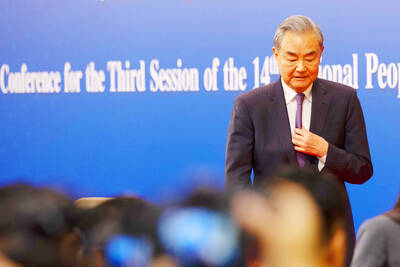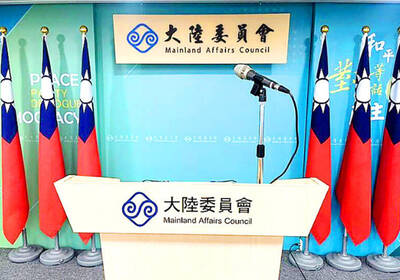The US and its G7 allies rolled out new sanctions against Russia’s “war machine” yesterday, targeting Moscow’s lucrative diamond trade and more entities linked to the invasion of Ukraine.
Leaders from the G7 wealthy democracies are meeting in Hiroshima, Japan, with Russia’s US$4 billion to US$5 billion annual trade in diamonds in the crosshairs.
Russian President Vladimir Putin’s invasion of Ukraine 15 months ago has prompted waves of sanctions that have helped plunge his country into recession and drained the Kremlin’s war chest.

Photo: Bloomberg
The G7 is looking to strengthen existing sanctions, closing loopholes and subjecting more Russian firms and their international partners to punitive restrictions.
Ukrainian President Volodymyr Zelenskiy is expected to address the summit by videoconference, with Japanese hosts tamping down speculation that he could make a last-minute, in-person appearance.
A senior US administration official yesterday said that 70 more entities from Russia and “other countries” would be placed on a US blacklist.
“And there will be upwards of 300 new sanctions against individuals, entities, vessels and aircraft,” the official said.
As the G7 weighs how to collectively choke Russia’s trade in diamonds — including high-tech methods of tracing — the UK announced its own “ban on Russian diamonds.”
“As today’s sanctions announcements demonstrate, the G7 remains unified in the face of the threat from Russia, and steadfast in our support for Ukraine,” British Prime Minister Rishi Sunak said.
“Russian diamonds are not forever,” European Council President Charles Michel said. “We will restrict trade in Russian diamonds.”
EU member state Belgium is among the largest wholesale buyers of Russian diamonds, along with India and the United Arab Emirates.
Economists are divided about how much G7 and other sanctions have hurt the Russian war effort. The Russian economy contracted 2.1 percent last year, a trend that continued early this year.
However, Moscow has adapted quickly, introducing strict capital controls, diverting trade to allies such as China and reportedly borrowing evasion techniques from sanctioned countries like Iran.

‘DANGEROUS GAME’: Legislative Yuan budget cuts have already become a point of discussion for Democrats and Republicans in Washington, Elbridge Colby said Taiwan’s fall to China “would be a disaster for American interests” and Taipei must raise defense spending to deter Beijing, US President Donald Trump’s pick to lead Pentagon policy, Elbridge Colby, said on Tuesday during his US Senate confirmation hearing. The nominee for US undersecretary of defense for policy told the Armed Services Committee that Washington needs to motivate Taiwan to avoid a conflict with China and that he is “profoundly disturbed” about its perceived reluctance to raise defense spending closer to 10 percent of GDP. Colby, a China hawk who also served in the Pentagon in Trump’s first team,

SEPARATE: The MAC rebutted Beijing’s claim that Taiwan is China’s province, asserting that UN Resolution 2758 neither mentions Taiwan nor grants the PRC authority over it The “status quo” of democratic Taiwan and autocratic China not belonging to each other has long been recognized by the international community, the Mainland Affairs Council (MAC) said yesterday in its rebuttal of Beijing’s claim that Taiwan can only be represented in the UN as “Taiwan, Province of China.” Chinese Minister of Foreign Affairs Wang Yi (王毅) yesterday at a news conference of the third session at the 14th National People’s Congress said that Taiwan can only be referred to as “Taiwan, Province of China” at the UN. Taiwan is an inseparable part of Chinese territory, which is not only history but

CROSSED A LINE: While entertainers working in China have made pro-China statements before, this time it seriously affected the nation’s security and interests, a source said The Mainland Affairs Council (MAC) late on Saturday night condemned the comments of Taiwanese entertainers who reposted Chinese statements denigrating Taiwan’s sovereignty. The nation’s cross-strait affairs authority issued the statement after several Taiwanese entertainers, including Patty Hou (侯佩岑), Ouyang Nana (歐陽娜娜) and Michelle Chen (陳妍希), on Friday and Saturday shared on their respective Sina Weibo (微博) accounts a post by state broadcaster China Central Television. The post showed an image of a map of Taiwan along with the five stars of the Chinese flag, and the message: “Taiwan is never a country. It never was and never will be.” The post followed remarks

INVESTMENT WATCH: The US activity would not affect the firm’s investment in Taiwan, where 11 production lines would likely be completed this year, C.C. Wei said Investments by Taiwan Semiconductor Manufacturing Co (TSMC, 台積電) in the US should not be a cause for concern, but rather seen as the moment that the company and Taiwan stepped into the global spotlight, President William Lai (賴清德) told a news conference at the Presidential Office in Taipei yesterday alongside TSMC chairman and chief executive officer C.C. Wei (魏哲家). Wei and US President Donald Trump in Washington on Monday announced plans to invest US$100 billion in the US to build three advanced foundries, two packaging plants, and a research and development center, after Trump threatened to slap tariffs on chips made